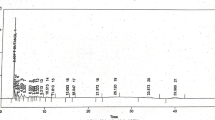Abstract
Curcuma caesia Roxb. (Zingiberaceae), known as black turmeric in English, is a perennial herb found throughout the Himalayan region, North-East and Central India. The plant has been traditionally used in India for several medicinal purposes. Present study was carried out to evaluate the methanol extract of C. caesia (MECC) rhizome for some in vitro antioxidant studies as because we know that many diseases are associated with reactive oxygen species (ROS) and reactive nitrogen species (RNS). Effect of MECC on ROS and RNS were evaluated in different in vitro methods like 1, 1-diphenyl-2-picrylhydrazil radical, hydroxyl radicals, superoxide anions, nitric oxide, hydrogen peroxide, peroxynitrite and hypochlorous acid. Lipid peroxidation, total phenolic content was also measured by standard assay method. The extract showed significant antioxidant activities in a dose dependent manner. The IC50 values for scavenging of free radicals were 94.03 ± 0.67 μg/ml, 155.59 ± 3.03 μg/ml, 68.10 ± 1.24 μg/ml, 21.07 ± 1.78 μg/ml, 260.56 ± 12.65 μg/ml and 33.33 ± 0.52 μg/ml for DPPH, nitric oxide, superoxide, hydroxyl, peroxynitrite and hypochlorous acid respectively. Reductive ability of the extract was also tested where dose dependent reducing capability was observed. The rhizome extract contains 677.7 μg of phenolic compound in 10 mg of the extract which is accounted for its free radical as well as antioxidant activity. From the above study it is concluded that the methanol extract of C. caesia rhizome is a potential source of natural antioxidant.









Similar content being viewed by others
References
Arulmozhi DK, Sridhar N, Veeranjaneyulu A, Arora SK (2006) Preliminary mechanistic studies on the smooth muscle relaxant effect of hydroalcoholic extract of Curcuma caesia. J Herb Pharmacother 6:117–124
Balavoine GG, Geletti YV (1999) Peroxynitrite Scavenging by different antioxidants. Part I: convenient study. Nitric Oxide 3:40–54
Beckman JS, Chen H, Ischiropulos H, Crow JP (1994) Oxidative chemistry of peroxynitrite, 233rd edn. Academic Press Inc, San Diego, pp 229–240
Box HC, Maccubbin AE (1997) Lipid peroxidation and DNA damage. Nutrition 13:920–921
Carroll LR, Sovitj P, Gerald MR (1995) Effect of anti-inflammatory drugs myeloperoxidase dependent hydroxyl radical generation by human neutrophil. Biochem Pharmacol 49:1079–1084
Cotelle A, Bernier JL, Catteau JP, Pommery J, Wallet JC, Gaydou EM (1996) Antioxidant properties of hydroxy-flavones. Free Radic Biol Med 20:35–43
Ferda C, Atalay S (2004) Effects of Rhus coriaria L. (anacardiaceae) on lipid peroxidation and free radical scavenging activity. Phytother Res 18:84–86
Halliwell B (1992) Reactive oxygen species and the central nervous system. J Neurochem 59:1609–1623
Hazra B, Biswas S, Mandal N (2008) Antioxidant and free radical scavenging activity of Spondias pinnata. BMC Compl Alternative Med 8:63–75
Hitchon CA, El-Gabalawy HS (2004) Oxidation in rheumatoid arthritis. Arthritis Res Ther 6:265–278
Huie RE, Padmaja S (1993) The reaction of NO with superoxide. Free Radic Res Commun 18:195–199
Ischiropoulos H, al-Mehidi AB, Fisher AB (1995) Reactive species in ischemic rat lung injury: contribution of peroxynitrite. Am J Physiol 269:L158–L164
Jayprakash GK, Singh RP, Sakariah KK (2001) Antioxidant activity of grape seed (vitis vinifera) extracts on peroxidation models in vitro. Food Chem 73:285–290
Kundu S, Bala A, Ghosh P, Mukhopadhya D, Mitra A, Sarkar A et al (2011) Attenuation of oxidative stress by allylpyrocatechol in synovial cellular infiltrate of patients with rheumatoid arthritis. Free Radic Res 45:518–526
Lin JY, Tang CY (2007) Determination of total phenolic and flavonoid contents in selected fruits and vegetables, as well as their stimulatory effects on mouse splenocyte proliferation. Food Chem 101:140–147
Medina J, Moreno-Otero R (2005) Pathophysiological basis for antioxidant therapy in chronic liver disease. Drugs 65:2445–2461
Mirshafiey A, Mohsenzadegan M (2008) The role of reactive oxygen species in immunopathogenesis of rheumatoid arthritis. Iran J Allergy Asthma Immunol 7:195–202
Mondal SK, Saha P, Mondal NB, Mazumder UK (2008) Free radical scavenging property of annona reticulata leave. Oriental Pharm and Exp Med 8:260–265
Ohkawa H, Oshishi N, Yagi K (1979) Assay for lipid peroxide in animal tissue by thiobarbituric acid reaction. Anal Biochem 95:351–358
Rajani GP, Ashok P (2009) In vitro antioxidant and antihyperlipidemic activities of Bauhinia variegata Linn. Indian J Pharmacol 41:227–232
Robak J, Gryglewski RJ (1998) Flavonoids are scavengers of superoxide anions. Biochem Pharmacol 37:837–841
Sasikuma B (2005) Genetic resources of curcuma: diversity, characterization and utilization. Plant Genet Resour 3:230–251
Sreejayan N, Rao MNA (1997) Nitric oxide scavenging by curcuminoids. J Pharm Pharmacol 49:105–107
Yazdanparast R, Ardestani A (2007) In vitro antioxidant and free radical scavenging activity of cyperus rotundus. J Med Food 10:667–674
Zhishen J, Mengcheng T, Jianming W (1999) The determination of flavonoid content in mulberry and their scavenging effects on superoxide radicals. Food Chem 64:555–559
Acknowledgements
The authors greatly acknowledge Himalayan Pharmacy Institute, Majhitar, E. Sikkim; Jadavpur University and NIPER, Kolkata for their technical Support.
Author information
Authors and Affiliations
Corresponding author
Rights and permissions
About this article
Cite this article
Karmakar, I., Dolai, N., Saha, P. et al. Scavenging activity of Curcuma caesia rhizome against reactive oxygen and nitrogen species. Orient Pharm Exp Med 11, 221–228 (2011). https://doi.org/10.1007/s13596-011-0030-6
Received:
Accepted:
Published:
Issue Date:
DOI: https://doi.org/10.1007/s13596-011-0030-6




